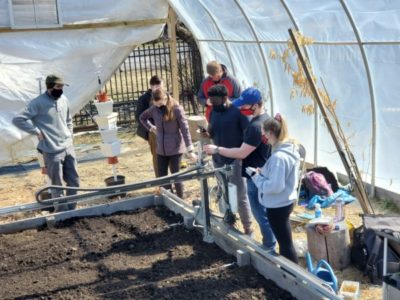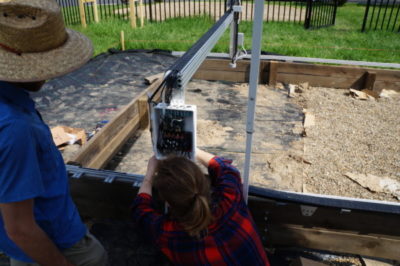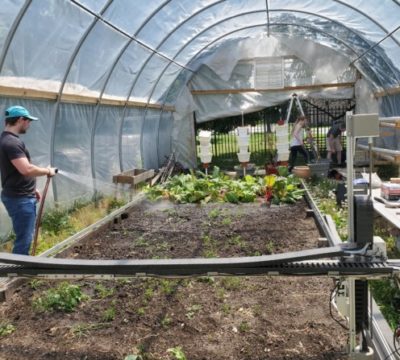Behind the Church of Christ of the Apostolic Faith in  Columbus, Ohio, a robot tends to a small community garden. It moves across tracks mounted on two-by-fours that allow it to operate along three axes in The Charles Madison Nabrit Memorial Garden while diligently tending to vegetables. Using a camera for vision and vacuum suction to manipulate objects, “Farmbot” can pick up tools, plant seeds, and weed and water plants.
Columbus, Ohio, a robot tends to a small community garden. It moves across tracks mounted on two-by-fours that allow it to operate along three axes in The Charles Madison Nabrit Memorial Garden while diligently tending to vegetables. Using a camera for vision and vacuum suction to manipulate objects, “Farmbot” can pick up tools, plant seeds, and weed and water plants.
Launched in 2019, Farmbot is an open-sourced robot funded through a $10,000 grant from Engineering Projects in Community Service (EPICS) in IEEE, a program that solves community challenges through service learning, a type of learning that happens through real-life experiences. The program has created a new, climate-resilient agricultural program that aims to solve hunger in the local community through sustainable technology. At the same time, it provides valuable STEM education programs for local college and K-12 students.
Harvesting Fresh Produce and STEM
The program is located in Brentnell, a predominantly Black neighborhood identified by the USDA as low-income, with 33 percent of households at or below the poverty level and 13 percent without vehicles. Like many urban neighborhoods in cities across the U.S., the community lacks access to grocery stores, the closest of which are over five miles away. This problem is part of a larger national trend. According to USDA, 0.5 percent (13.8 million) of U.S. households were food insecure at some point during 2020, a problem that disproportionately affects Black households.
 Farmbot is helping to solve this problem by providing fresh vegetables to be used in the local farmer’s market held at the same location. The farmer’s market takes place weekly (alternating between Wednesdays and Saturdays) where organic food can be purchased for 1$/lb. An oven installed in the garden is also used to bake pizza for locals, which is made from ingredients sourced from the garden.
Farmbot is helping to solve this problem by providing fresh vegetables to be used in the local farmer’s market held at the same location. The farmer’s market takes place weekly (alternating between Wednesdays and Saturdays) where organic food can be purchased for 1$/lb. An oven installed in the garden is also used to bake pizza for locals, which is made from ingredients sourced from the garden.
Another major goal of the program is to create science, technology, engineering and math (STEM) learning opportunities for local students. The program, part of the Food, Agriculture, and Biological Engineering Department at Ohio State University, partnered with the community garden to create a service-learning in engineering course for university students. The Farmbot project, which includes a rainwater catchment, automated irrigation, and a solar electric generator, also provides renewable-energy themed STEM education modules for K-12 students who frequent the garden. Students learn hands-on technical skills varying from coding, square-inch calculations, energy calculations, and prioritizing efficiency. A special program held in the summer enlists support from returning OSU students, who are paid $15 an hour for their work.
A Small Garden With a Huge Impact
The idea to bring Farmbot to Columbus began when Prof. David Delaine, a lecturer in the Department of Engineering Education at Ohio State, and his students, became interested in pursuing a local partnership for promoting STEM Education. A colleague of Delaine’s was a volunteer at the local garden with whom he had a long relationship. After discussing it, the idea to install a robot in the garden that could simultaneously tackle the problems of hunger, sustainability, and STEM education in the neighborhood was born.
“An urban garden is an excellent place for students to work on engineering projects,” Prof. Delaine stated regarding sustainability combined with engineering. 
Since it debuted, approximately 50 pre-university students have engaged with the program, with 15 undergraduate students directly enrolling each spring. OSU students volunteered over 2,000 hours in total last summer through several student organizations.
The program is partnering with other university organizations that focus on food insecurity (NOURISH), engineering design (Design for Ninety), and engineering in the Black student community (National Society of Black Engineers). It has also attracted a large number of female students, with approximately a 60/40 female to male ratio. The department is hoping to leverage its relationships with the student organizations to increase its racial diversity.
“Quantifying impacts of that sort is difficult,” said Prof. Delaine when asked about measurable impacts with students. He explained that simply having a program that alleviates food insecurity while promoting STEM education is likely impacting these students in ways that cannot yet be measured.
He said the program is focused on continuing to invest in and improve upon current projects as opposed to starting new ones and hopes it can serve as a model for other projects and communities. He is proud of how the project is shaping students into future engineers. Within the coursework, OSU faculty and family members of the late Charles Madison Nabrit, a former CCAF church member after whom the garden is memorialized, have taught empathy and cultural differences, and believe that justice, equity, and relationships are important aspects of being an engineer.
The project’s impact is expected to reach beyond the U.S. Some of the students involved in installing the Farmbot and renewable energy infrastructure plan to travel to Guyana soon, where they will apply their knowledge to a similar project.
As a completely open-sourced robot, the Farmbot may someday be used to teach students how to write their own code and create different parts for the Farmbot. Furthermore, the department is hoping to leverage its relationships with the student organizations to increase its racial diversity.

Recent Comments